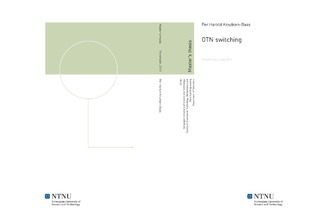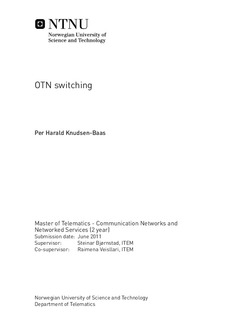| dc.description.abstract | Increasing traffic volumes in the Internet put strict requirements to the architectureof optical core networks. The exploding number of Internet users, andmassive increase in Internet content consumption forces carriers to constantlyupgrade and transform their core networks in order to cope with the trafficgrowth. The choice of both physical components and transport protocols inthe core network is crucial in order to provide satisfactorily performance.Data traffic in the core network consists of a wide variety of protocols.OTN is a digital wrapper technology, responsible for encapsulating existingframes of data, regardless of native protocol, and adding additional overheadfor addressing, OAM and error control. The wrapped signal is thentransported directly over wavelengths in the optical transport network. Thecommon OTN wrapper overhead makes it possible to monitor and controlthe signals, regardless of the protocol type being transported.OTN is standardized by the ITU through a series of recommendations,the two most important being ITU-T G.709 - "Interfaces for the OpticalTransport Network", and ITU-T G.872 - "Architecture of the Optical TransportNetwork". OTN uses a flexible TDM hierarchy in order to provide highwavelength utilization. The TDM hierarchy makes it possible to performswitching at various sub-wavelength bit rates in network nodes.An introduction to OTN and an overview of recent progress in OTNstandardization is given in the thesis. An OTN switch which utilizes theflexible multiplexing hierarchy of OTN is proposed, and its characteristics istested in a network scenario, comparing it to the packet switched alternative.Simulation results reveal that OTN switching doesn t provide any performancebenefits compared to packet switching in the core network. OTNswitches do however provide bypass of intermediate IP routers, reducing therequirements for router processing power in each network node. This reducesoverall cost, and improves network scalability.An automatically reconfigurable OTN switch which rearranges link subcapacitiesbased on differences in output buffer queue lengths is also proposedand simulated in the thesis. Simulation results show that the reconfigurableOTN switch has better performance than both pure packet switching andregular OTN switching in the network scenario. | nb_NO |

